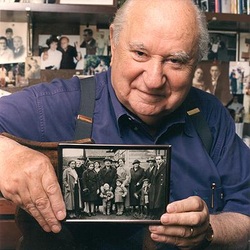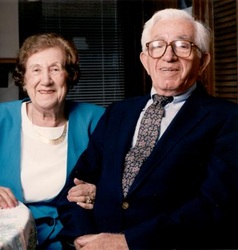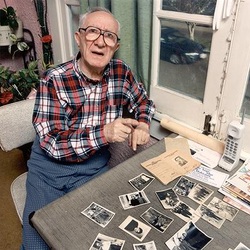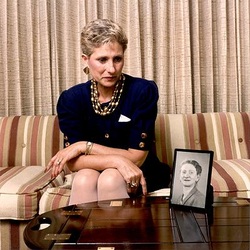RECOVERY
The Holocaust
In 1933, Adolf Hitler was named Chancellor of Germany by President Paul von Hindenburg. After Hindenburg's death in 1934, Hitler declared himself the fuhrer, or "leader," of Germany. Hitler's National Socialist German Workers' Party (Nazi Party) quickly dominated the Reichstag (German parliament) and implemented their anti-Semitic ideology throughout the country. The 1935 Nuremberg Laws deprived Jews of their citizenship and forced them to wear a yellow Star of David badge. Marriage between Jews and Gentiles (non-Jews) was forbidden. Fearing the increasingly hostile German government, about 90,000 German & Austrian Jews fled prior to the outbreak of World War II in 1939. The Nazis frequently used propaganda to spread anti-Semitic feelings. Jews were condemned as scapegoats for Germany’s economic and social problems, as well as for supposedly causing Germany’s defeat in WWI by "stabbing the nation in the back."
The paramilitary organization called the Schutzstaffel, abbreviated as the S.S., directly served Hitler's aspirations for the genocide of "undesirable people," specifically Jews. This operation was called the “final solution of the Jewish question," and is commonly known today as the Holocaust. Heinrich Himmler, the leader of the S.S., was chief architect of the operation. As the German army conquered nearby European nations, such as Poland, Czechoslovakia, France, and Russia, the S.S. followed and rounded up Jews. Those that were capable of conducting forced labor were placed in concentration camps, while those who weren't, mainly women and children, were sent to death camps. Families were torn apart and the people were brutally treated. An estimated 6 million Jews were killed out of the 10 million that had lived in Europe prior to World War II. An additional 7 million “undesirables” were killed as well, including gypsies, homosexuals, Jehovah’s Witnesses, and Communists.
Below is a documentary with first-hand footage of the atrocities committed by the Nazis. There are frighteningly thin corpses scattered throughout the camp, furnaces that contain the remains of victims, and a few fortunate survivors in extremely frail condition. As a warning, the video may be quite disturbing and grotesque to watch.
The paramilitary organization called the Schutzstaffel, abbreviated as the S.S., directly served Hitler's aspirations for the genocide of "undesirable people," specifically Jews. This operation was called the “final solution of the Jewish question," and is commonly known today as the Holocaust. Heinrich Himmler, the leader of the S.S., was chief architect of the operation. As the German army conquered nearby European nations, such as Poland, Czechoslovakia, France, and Russia, the S.S. followed and rounded up Jews. Those that were capable of conducting forced labor were placed in concentration camps, while those who weren't, mainly women and children, were sent to death camps. Families were torn apart and the people were brutally treated. An estimated 6 million Jews were killed out of the 10 million that had lived in Europe prior to World War II. An additional 7 million “undesirables” were killed as well, including gypsies, homosexuals, Jehovah’s Witnesses, and Communists.
Below is a documentary with first-hand footage of the atrocities committed by the Nazis. There are frighteningly thin corpses scattered throughout the camp, furnaces that contain the remains of victims, and a few fortunate survivors in extremely frail condition. As a warning, the video may be quite disturbing and grotesque to watch.
Although many people today solely blame the Nazis for the atrocities of the Holocaust, the genocide was also aided by people all over Europe. After France surrendered to Germany, the French government officials rounded up Jews and turned them over to the Nazis before they were even asked to do so. In the Ukraine and Croatia, the local population rounded up Jews on their own initiative. The majority of nations in the world, including the United States, were reluctant to accept Jewish refugees to their countries. The harsh reality was that anti-Semitic feelings ran deep throughout the world during the first half of the twentieth century, ultimately leading to the genocide of millions of Jews.
The Recovery
After liberation from concentration camps, many Jewish Holocaust survivors were afraid to return to their former homes because of the anti-semitism that persisted in parts of Europe. For example, there were a number of pogroms (anti-Jewish riots) in postwar Poland. With limited options for emigration, tens of thousands of Holocaust survivors migrated west to European territories liberated by the Allied forces of the United States and Great Britian. They were housed in a number of refugee centers and displaced persons camps such as Bergen-Belsen in Germany. The United Nations Relief and Rehabilitation Administration (UNRRA) as well as the occupying armies of the United States, Great Britain, and France administered these relief camps.
A wide variety of Jewish agencies worked to assist the Holocaust refugees. For example, the American Jewish Joint Distribution Committee provided survivors with food and clothing. Refugees also formed their own organizations, and many labored for the establishment of an independent Jewish state in Palestine. After World War I, the League of Nations had granted Great Britain the “Mandate for Palestine” in the Balfour Declaration. With this mandate, the British had held the responsibility for securing "the establishment in Palestine of a national home for the Jewish people." However, this did not become a reality until the May of 1948, when the state of Israel was declared as a homeland for the Jews. With the establishment of Israel, Jewish refugees began streaming into the new sovereign state. As many as 170,000 Jewish refugees had immigrated to Israel by 1953.
Problems for the Jewish people did not cease with the creation of a homeland. The day after the declaration of the state of Israel, the Arab neighbors of the new state declared war. The resulting conflict became known as the Arab-Israeli War, in which Israel defended the entire, long border of the country against Lebanon and Syria in the north, Iraq and Jordan in the east, and Egypt in the south. Over 6,000 Israelis were killed in action. From day one of Israel's history, great tension existed amongst it and its Arab neighbors. Even today, disputes exist in the Middle East regarding territory, borders, and religion.
Holocaust Remembrance Day is celebrated today in honor of those that were killed by the Nazis during the Holocaust. It takes place on the 27th of Nisan, a month of the Hebrew calendar. Holocaust Remembrance Day is called Yom Hashoah in Hebrew. The previous Yom Hashoah occurred on May 2, and the next one will be on April 19, 2012.
Over 6 million Jewish people and 7 million "undesirables" were slaughtered by Hitler's Nazi forces. Those that were fortunate enough to survive found themselves displaced and without a home. Although the Jewish people managed to find refuge in foreign countries, including their new homeland of Israel, the consequences of the Holocaust are still felt today. With the arrival of Jews to the Middle East, countless conflicts have emerged between Israelis and Arabs. Today, the worldwide Jewish population is only about 13 million, less than the pre-Holocaust population of about 15 million. The recovery of the Jewish people after the Holocaust is still in progress. Conflicts still rage in the Middle East today and the Jewish population has remained stagnant. Only time will tell how effectively the Jewish people have responded to the horrors of the Holocaust.
Click on the following links to learn more about the:
Aftermath of the Holocaust
Arab-Israeli Wars
Holocaust Remembrance Day
A wide variety of Jewish agencies worked to assist the Holocaust refugees. For example, the American Jewish Joint Distribution Committee provided survivors with food and clothing. Refugees also formed their own organizations, and many labored for the establishment of an independent Jewish state in Palestine. After World War I, the League of Nations had granted Great Britain the “Mandate for Palestine” in the Balfour Declaration. With this mandate, the British had held the responsibility for securing "the establishment in Palestine of a national home for the Jewish people." However, this did not become a reality until the May of 1948, when the state of Israel was declared as a homeland for the Jews. With the establishment of Israel, Jewish refugees began streaming into the new sovereign state. As many as 170,000 Jewish refugees had immigrated to Israel by 1953.
Problems for the Jewish people did not cease with the creation of a homeland. The day after the declaration of the state of Israel, the Arab neighbors of the new state declared war. The resulting conflict became known as the Arab-Israeli War, in which Israel defended the entire, long border of the country against Lebanon and Syria in the north, Iraq and Jordan in the east, and Egypt in the south. Over 6,000 Israelis were killed in action. From day one of Israel's history, great tension existed amongst it and its Arab neighbors. Even today, disputes exist in the Middle East regarding territory, borders, and religion.
Holocaust Remembrance Day is celebrated today in honor of those that were killed by the Nazis during the Holocaust. It takes place on the 27th of Nisan, a month of the Hebrew calendar. Holocaust Remembrance Day is called Yom Hashoah in Hebrew. The previous Yom Hashoah occurred on May 2, and the next one will be on April 19, 2012.
Over 6 million Jewish people and 7 million "undesirables" were slaughtered by Hitler's Nazi forces. Those that were fortunate enough to survive found themselves displaced and without a home. Although the Jewish people managed to find refuge in foreign countries, including their new homeland of Israel, the consequences of the Holocaust are still felt today. With the arrival of Jews to the Middle East, countless conflicts have emerged between Israelis and Arabs. Today, the worldwide Jewish population is only about 13 million, less than the pre-Holocaust population of about 15 million. The recovery of the Jewish people after the Holocaust is still in progress. Conflicts still rage in the Middle East today and the Jewish population has remained stagnant. Only time will tell how effectively the Jewish people have responded to the horrors of the Holocaust.
Click on the following links to learn more about the:
Aftermath of the Holocaust
Arab-Israeli Wars
Holocaust Remembrance Day
Individuals
Read about the incredible stories of six Holocaust survivors by clicking on the images below!
Six Million Paper Clips by Peter Schroeder

Students in a small Tennessee town are learning about the Holocaust. When their teachers tell them that the Nazis killed over six millions Jews, they couldn't fully understand because they didn't know what six million looked like. During the Holocaust, paper clips were attached to clothing to symbolize someone that was killed. The teachers of the class came up with an idea to try to collect as many paper clips are they could to better understand such a large number. At first, the teachers were expecting to receive a few thousand at the most. The students and teachers slowly began to become overwhelmed as thousands of envelopes were being delivered daily. Some people sent one or two paper clips in honor of family members they had lost, and other people sent upwards of close to 50,000. Soon the entire soon become involved when they realized they were collecting millions of paperclips. The students received paper clips from survivors, famous actors, athletes, and even the president. Believe it or not, the class actually collected all six million paper clips. All of the paper clips are now on display and it has been made into a small museum. This new memorial allows people to fully understand how many people were killed and how many families had to suffer loses.





